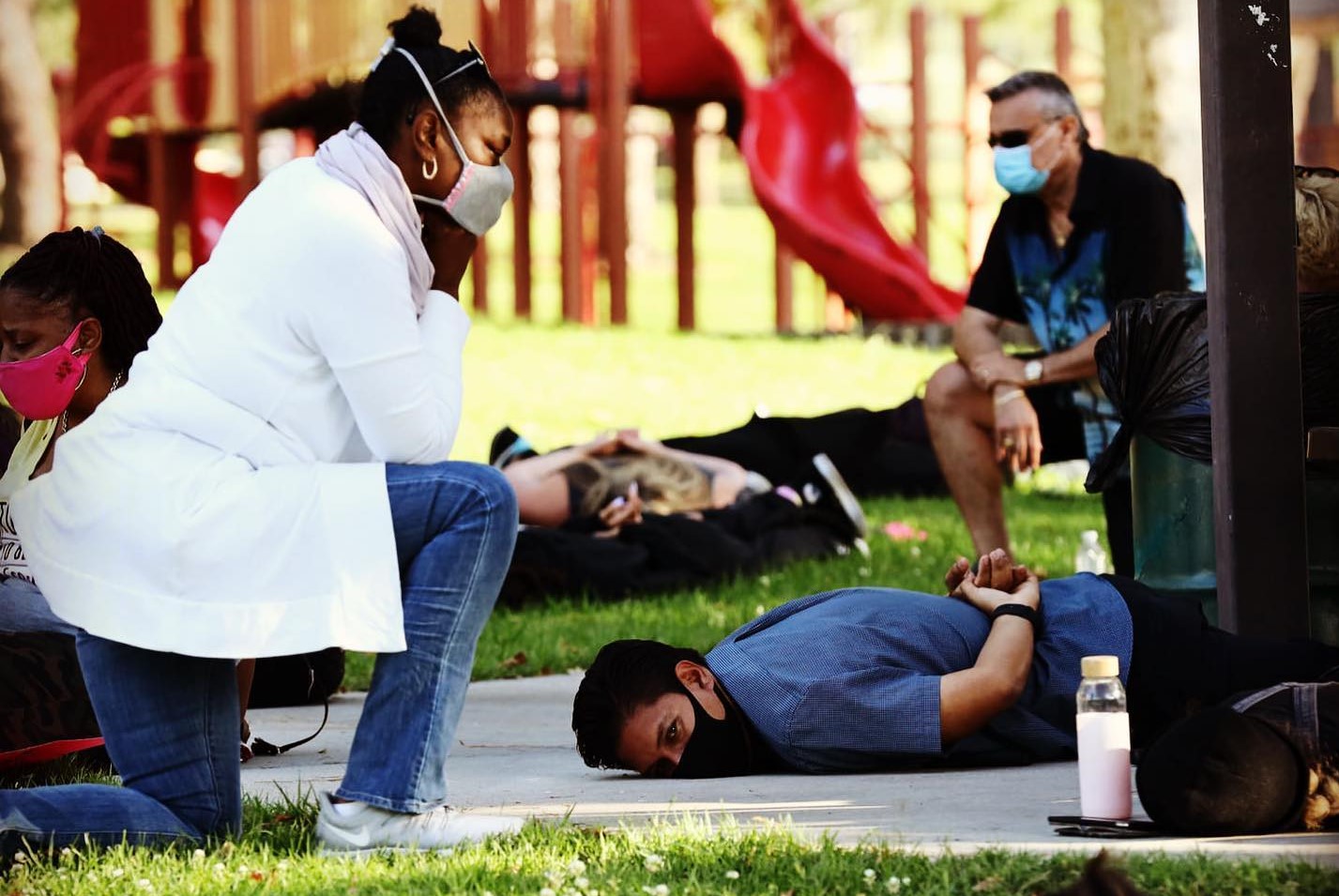A protest is a statement or action expressing disapproval or objection to something. A protest is meant to convey this message in public, and can include dancing, chanting, sitting or even silence to convey the message. As followers of Christ, we are called to act justly, to love mercy and to walk humbly with God (Micah 6:8). One way Christians can bring change to societal injustice is through peaceful protest. Often, faith groups participate in peaceful protests such as vigils, where silence, prayer and the Word are shared. United Methodists have a history of participating in peaceful (or non-violent) protests in an effort to effect change throughout the world.
The following tips will help faith-based groups communicate a message through a peaceful protest.
Planning
 Jaimes advocating for racial justice after recent killings of unarmed African Americans. Photo courtesy of David Jaimes.
Jaimes advocating for racial justice after recent killings of unarmed African Americans. Photo courtesy of David Jaimes. Gather a team. This team usually consists of a group of people who share a similar belief and are willing to organize to express their message publicly. Usually, in the planning stage, the individuals participating in the protest represent different organizations, community groups or churches. It is important to identify a trusted person or organization to lead efforts to increase credibility and ensure consistency in the action and message.
Identify your message. The message needs to be as simple as possible. Observers should be able to easily identify what you are trying to convey. The impact of a concise and emphatic statement must not be underestimated.
Develop a program/agenda. A protest can be likened to a church service. As such, organizers of the peaceful protest should develop a program that includes times, dates and locations. Some questions to consider are: How will the program start? What form will it take? Will there be a small sharing of the Word? Will the arts be used to convey the message more powerfully? Organizers should be able to answer these questions. Additionally, organizers should identify speakers and agree on what content each speaker will share to the wider wider group.
Check your local laws. Every city, county, and state has a level of tolerance for peaceful protests. That’s what the United States offers: free speech under the First Amendment. Look up your local city/county's laws on peaceful protests. Depending on your context, you may need a permit to march, use loud devices or be present at certain public spaces. Additionally, notifying the authorities gives the police department a heads up and allows them to be present at the site to ensure things don’t escalate. This is common practice for peaceful protests and local authorities must abide by them.
Spreading the Word
After solidifying a time, date and location, you can create content to promote your protest.
Create a flyer. Share it across the local and virtual community. Make sure to include key points such as where to meet, what time to meet, which date, and who the speakers might be. You may also want to include your website or social media handles where people can find additional information.
Social media. Social media is the most useful and accessible way to communicate information about a protest. Specific examples include Facebook, Facebook Live, Instagram, Twitter, TikTok, Snapchat and YouTube. While each platform is different, adapt your content to match the use and users of each platform. For example, you can create an event on Facebook, a short video on TikTok and encourage people to tweet about your event on Twitter.
Traditional media. Traditional media, including television, radio and newspapers are useful in promoting the protest, but are also useful in spreading the message of the protest through news coverage. Organizers should share the protest information with any media contacts they have and invite reporters to the location. If you don’t have a contact list, social media really bridges the gap for connecting with the local media because they can easily contact you. Even if you don’t have media contacts, you can find contact information for your local TV news stations on their websites.
Word-of-Mouth. Finally, phone calls, text messages, emails and (socially distanced) face-to-face contact remain useful ways to secure your speakers and people’s attendance. Additionally, stay connected with your team of organizers through a group chat or other meeting platforms that will allow you to share documents and information.
The Big Day
 Group of local faith community participates in a moment of silence and solidarity in commemoration of the life of George Floyd in Orange County, CA. Photo courtesy of David Jaimes.
Group of local faith community participates in a moment of silence and solidarity in commemoration of the life of George Floyd in Orange County, CA. Photo courtesy of David Jaimes. Earlier in the planning of the event, do a walk around of the location. Consider the parking availability, street signs and street direction. You’ll want to communicate these logistics to the attendees. While ensuring that everything is in order and ready for the big day, make sure the police department has been notified, get snacks, water, donations and have a “sign party” or a fun time to gather people and make custom signs for your protest.
Stay connected. Ensure that the core group of organizers is constantly in communication. During the protest, a group chat usually works best. Some leaders of the group may want to linger around strategic areas of the site to keep instigators from escalating attention, ensuring people are safe and have accessibility on site as well as communicating lost and found items. Some emergency contact information to consider have easily accessible are numbers for the police department and health officials.
Be present. When you are at the protest, be fully present. While you may have a plan for every detail, understand that things will change. You may find that items on your agenda get switched around, a speaker doesn’t show up, or a group of instigators tries to distract the protest. It’s important to be able to adapt to the changes while continuing to stay on task as much as possible.
Stay on message. Be sure everyone in your group knows why they are there and the specific message meant to be conveyed. Employ a hashtag or sign as a reminder. Upload pictures on social media and do Facebook lives or Instagram Lives. Make sure to respond to comments and stay active online. Assign an individual to be dedicated to each of these tasks.
Handling instigators on site. Anything that distracts from your message reduces the effectiveness of the protest. While you can’t control everyone, you need to limit the people who may derail your message and their actions. As a faith-based organization, you can handle it in a peaceful way by giving instigators a space to express themselves or you can pull them aside and ask them to stop. You may also ask police officers to intervene on your behalf. In situations where tensions escalate, keep a distance and practice “de-escalation tactics”.
While change needs to be driven and supported by a complex network of systems and organizations, peaceful protests are a way for faith-based groups to lead social change and publicly witness of our faith with acts of justice.
Examples of United Methodists participating in protests:
- United Methodists preach, protest and decry racism
- Disappointment with immigration ruling
- United Methodists support students, protesting teachers
- Churchgoers protest electric chairs return
- Pipeline protest supporters cheer re-route ruling
- United Methodists join in Ferguson protest

David Jaimes is a faith-rooted community organizer for CLUE (Clergy and Laity United for Economic Justice). He is a recent graduate of Fuller Theological Seminary and a candidate for ordination within the California-Pacific Annual Conference. He currently serves at Santa Ana UMC.
Aileen Jimenez is manager of Hispanic/Latino leader communications at United Methodist Communications, Nashville, Tennessee, U.S.A. You can reach her at ajimenez@umcom.org.

